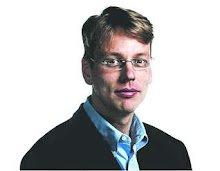Originally printed April 8, 2012.
I became intrigued especially with the original score produced for the film by University of Iowa music professor David Gompper.
During a phone interview Thursday, Gompper said it was his only experience working with a film director. So he first had to struggle with answering the question, "How do you transform these overwhelming and disturbing images into something musical?"
Gompper said his work usually focuses on "music in the abstract" — music that stands on its own, without dance, film or any other visual element.
So before he started composing, Gompper went with Wyrick to take a tour of Lasansky's artwork in the storage section of the UI Museum of Art. While viewing the large-scale, human-size drawings, Gompper said he kept thinking of the work of the French composer Olivier Messiaen, who was made a prisoner of war by the Nazis after the fall of France in 1940.
While in the prison camp, Messiaen composed his "Quartet for the End of Time" for the four instruments available to him — piano, violin, cello and clarinet. The piece was first performed by Messiaen and his fellow risoners for an audience of inmates and guards.
Gompper said he didn't borrow any specific melodies or chords structures from Messiaen, but he did work to "tap into that experience" and recreate a similar aesthetic in his score — something he hoped would provide a musical contrast to Lasansky's images.
Like any other film composer, he also had to learn to work with Wyrick's editing and narrative plan —composing pieces that would fit the 19 seconds in one scene or the 37 seconds in the next. For each segment, he tried to compose music that included a beginning, middle and end. And when Wyrick would decide to cut 10 seconds from this section or 17 section from that one, Gompper would have to rework the music to fit the new time lengths.
Although he found some of the Nazi drawings to be more disturbing than others — especially those illustrating what Lasansky viewed as the complicity between the church and the Nazis — Gompper said he initially was responding to the collection as a whole rather than trying to convey the story of any individual drawing.
Gompper soon found, however, that viewing the drawings as a group had its limitations. Although the drawings share many similarities with each other, they also feature important differences. That's what allows them to explore a fuller range of human reactions to torture, pain, suffering and degradation.
When viewing an early cut of the film, Gompper suddenly realized that his score — when placed in direct contrast with Lasansky's images — didn't keep pace with the shifting emotional reactions the collection elicits.
"I didn't modulate," Gompper said, and as a result, the music grew somewhat stale.
So Gompper decided to rewrite the whole score.
He re-imagined.
He transposed.
And he made sure that every segment — no matter how short — would be able to stand on its own.
The result worked. Wyrick's documentary, finished in 1999, went on to win a number of awards — including a 2004 Mid-America Emmy Award for Outstanding Achievement.
More importantly, Gompper's score helped Wyrick's film convey the importance of the "The Nazi Drawings" to a new generation.
"It's a 25-minute documentary," Wyrick said in a phone interview Wednesday. "And at the end, instead of the obligatory clapping, people usually sit there just stunned in their seats."
Opinion editor Jeff Charis-Carlson can be contacted at jcharisc@press-citizen.com.

No comments:
Post a Comment